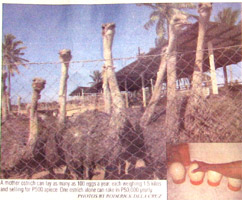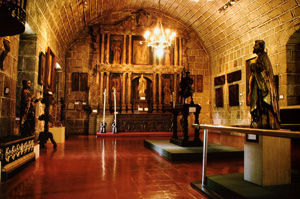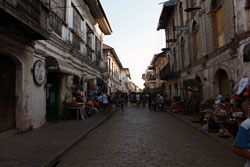Imagine an egg, which weighs one and a half kilo and hatches into a chick as large as a full-grown hen. Imagine its long-necked mother, taller and heavier than most men, with powerful legs running as fast as a car. Imagine 600 of these creatures huddling as a herd in a farm nestled on the mountain. Fascinated yet scared, visitors of the farm are relieved to know that ostriches don't fly.
 Raised as livestock animals weighing over 100 kilos each, around 600 ostriches – descendants of several pairs brought from Australia and the United States – found a home in the 10-hectare Philippine Ostrich and Crocodile Farms, Inc., an upland ranch owned by the Filipino-Chinese Limketkai family in Barangay Malanang. In the nearby Cagayan de Oro City, the Limketkai family owns one of the oldest and most familiar shopping malls.
Raised as livestock animals weighing over 100 kilos each, around 600 ostriches – descendants of several pairs brought from Australia and the United States – found a home in the 10-hectare Philippine Ostrich and Crocodile Farms, Inc., an upland ranch owned by the Filipino-Chinese Limketkai family in Barangay Malanang. In the nearby Cagayan de Oro City, the Limketkai family owns one of the oldest and most familiar shopping malls.
The playful giant birds, unafraid of shorter humans, stretch their necks above the seven-foot barbed-wired fence to mingle with fascinated tourists. While they delight tourists simply by showing their huge form and round unsuspecting eyes, they are kept in the farm, primarily not for tourism, but to supply low-fat meat to fine diners in Metro Manila and other urban centers.
 The Department of Tourism (DOT) has unveiled the redevelopment plan for the resort island of Boracay, which will give existing developers a ten-year transition period to comply with the new plan and investors to build more hotels and resorts over 123 hectares of new areas. Tourism Secretary Ace Durano said a part of the plan is a possible PhP1.2 billion investment by Manila Water to improve water services and sewerage system on the island. The target is to provide water services to the whole island by 2011 and sewerage system by 2012. The Philippine Tourism Authority (PTA) is also investing PhP200 million to build new ports and a three-kilometer circumferential road in Barangay Balabag to decongest the existing road, which will be made a one-way lane. Durano said the comprehensive land use plan, prepared by architectural consultancy firm CEST Inc., will enable Boracay to accommodate as many as 2.2 million visitors by 2018, or three times the 700,000 visitors projected this year.
The Department of Tourism (DOT) has unveiled the redevelopment plan for the resort island of Boracay, which will give existing developers a ten-year transition period to comply with the new plan and investors to build more hotels and resorts over 123 hectares of new areas. Tourism Secretary Ace Durano said a part of the plan is a possible PhP1.2 billion investment by Manila Water to improve water services and sewerage system on the island. The target is to provide water services to the whole island by 2011 and sewerage system by 2012. The Philippine Tourism Authority (PTA) is also investing PhP200 million to build new ports and a three-kilometer circumferential road in Barangay Balabag to decongest the existing road, which will be made a one-way lane. Durano said the comprehensive land use plan, prepared by architectural consultancy firm CEST Inc., will enable Boracay to accommodate as many as 2.2 million visitors by 2018, or three times the 700,000 visitors projected this year.
 Raised as livestock animals weighing over 100 kilos each, around 600 ostriches – descendants of several pairs brought from Australia and the United States – found a home in the 10-hectare Philippine Ostrich and Crocodile Farms, Inc., an upland ranch owned by the Filipino-Chinese Limketkai family in Barangay Malanang. In the nearby Cagayan de Oro City, the Limketkai family owns one of the oldest and most familiar shopping malls.
Raised as livestock animals weighing over 100 kilos each, around 600 ostriches – descendants of several pairs brought from Australia and the United States – found a home in the 10-hectare Philippine Ostrich and Crocodile Farms, Inc., an upland ranch owned by the Filipino-Chinese Limketkai family in Barangay Malanang. In the nearby Cagayan de Oro City, the Limketkai family owns one of the oldest and most familiar shopping malls. As the capital city of Ilocos Sur province, Vigan is a beautiful Hispanic city most known for its cobblestone street called Calle Crisologo. Spanish houses dating back to the 18th century still stand on the site, which is frequented by both foreign and domestic tourists. Of course, there are other streets in Vigan that are also lined with old houses bearing the influence of European architecture.
As the capital city of Ilocos Sur province, Vigan is a beautiful Hispanic city most known for its cobblestone street called Calle Crisologo. Spanish houses dating back to the 18th century still stand on the site, which is frequented by both foreign and domestic tourists. Of course, there are other streets in Vigan that are also lined with old houses bearing the influence of European architecture.